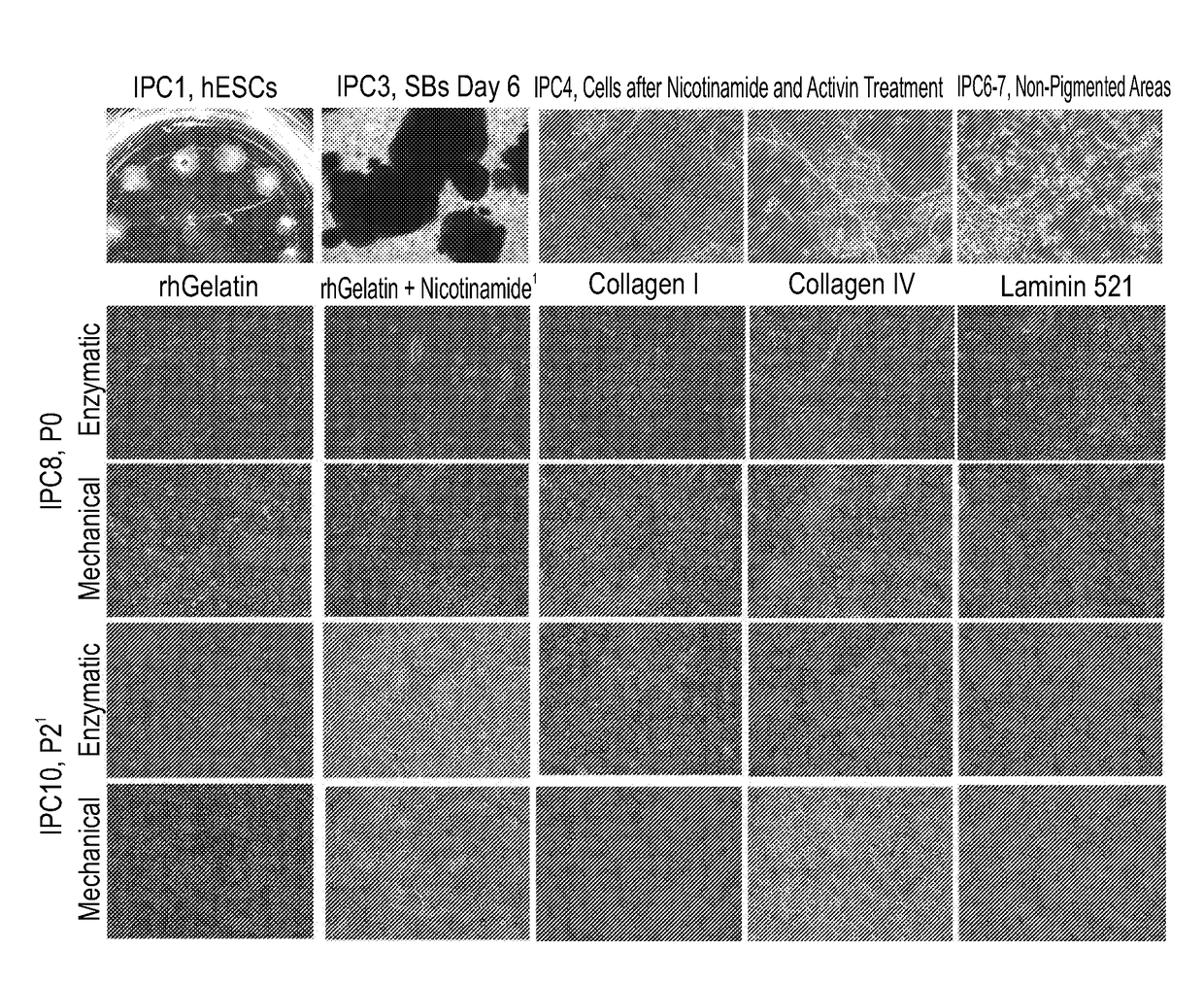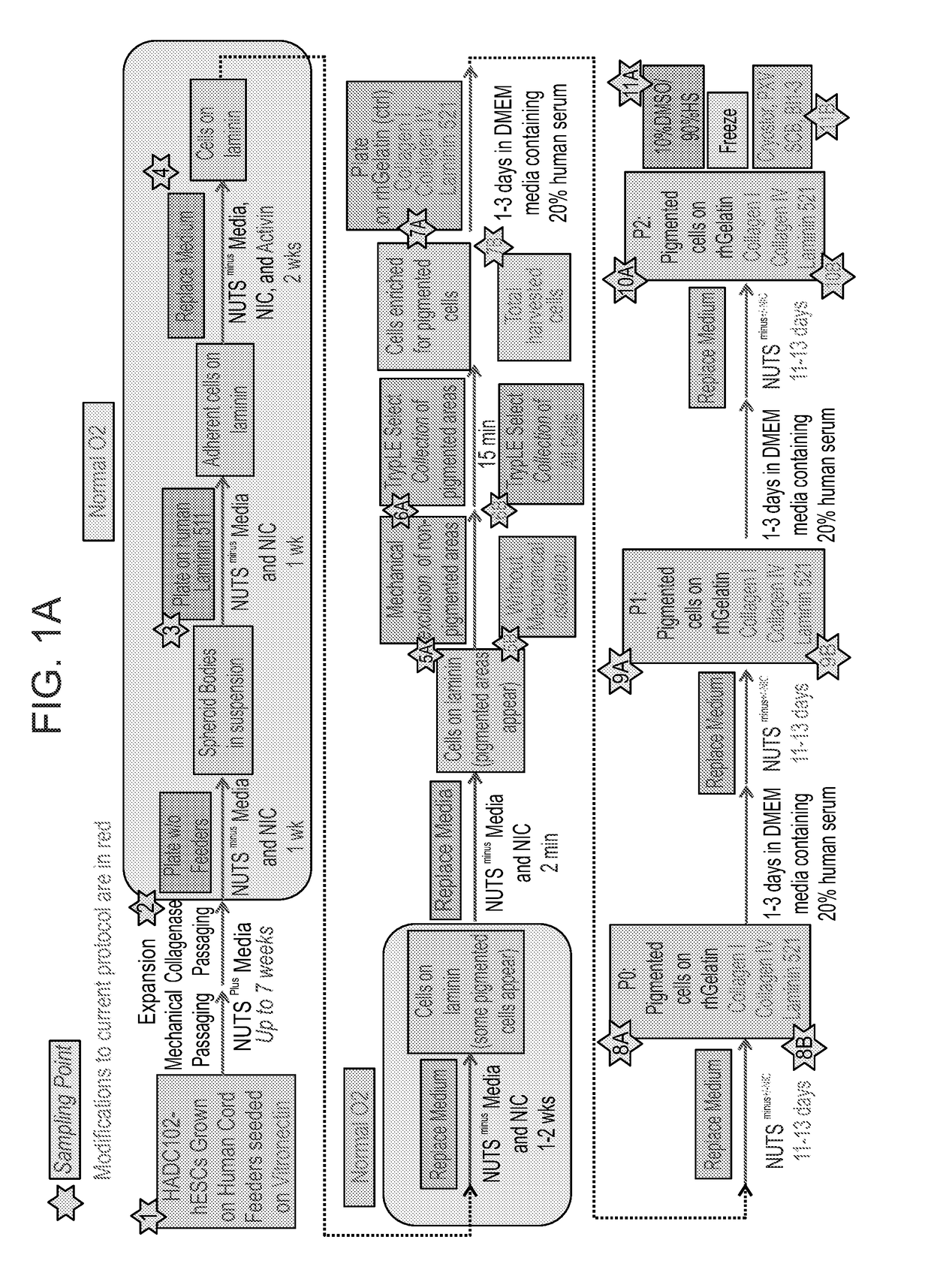Preparation of retinal pigment epithelium cells
a technology of pigment epithelium cells and retinal pigment, which is applied in the direction of embryonic cells, anti-inflammatory agents, drug compositions, etc., can solve the problems of limited widespread use of these donor sources, limited pigmented cells, and laborious time-consuming current protocols for the derivation of rpe cells from pluripotent stem cells
- Summary
- Abstract
- Description
- Claims
- Application Information
AI Technical Summary
Benefits of technology
Problems solved by technology
Method used
Image
Examples
example 1
[0216]This Example analyzes the effect of no-mechanical selection of RPE cells generated as described below.
[0217]Materials and Methods
[0218]Generation of RPE Cells:
[0219]xeno-free GMP grade HAD-C 102 hESCs were expanded as colonies on irradiated xeno-free GMP-grade CRD008 hUCFs that were seeded on recombinant human vitronectin (rhVTN). hESC expansion was carried out in the presence of Nutristem medium that contains human serum albumin in addition to the growth factors basic FGF and TGF beta (Biological Industries 05-100-1A). Expanded hESCs were then transferred to a suspension culture to initiate differentiation in a directed manner under normal O2 conditions. Spheroid bodies (SBs) were formed and then plated as an adherent cell culture under continued directed differentiation conditions towards a neural fate and subsequently towards an RPE cell fate (FIG. 1). At the end of the differentiation phase, cells were harvested using the following two techniques and expanded 1) Non-pigmen...
example 2
[0236]This Example analyzes the effect of no-mechanical selection of RPE cells generated as in Example 1, in a repeat production process.
[0237]Materials and Methods
[0238]Generation of RPE cells:
[0239]xeno-free GMP grade HAD-C 102 hESCs were expanded as colonies on irradiated xeno-free GMP-grade CRD008 hUCFs that were seeded on recombinant human gelatin. hESC expansion was carried out in the presence of Nutristem medium that contains human serum albumin in addition to the growth factors basic FGF and TGF beta (Biological Industries 05-100-1A). Expanded hESCs were then transferred to a suspension culture to initiate differentiation in a directed manner under low O2 conditions (5%). Spheroid bodies (SBs) were formed and then plated as an adherent cell culture under continued directed differentiation conditions towards a neural fate and subsequently towards an RPE cell fate (FIG. 1B). At the end of the differentiation phase, cells were harvested using the following two techniques and ex...
PUM
| Property | Measurement | Unit |
|---|---|---|
| volume | aaaaa | aaaaa |
| density | aaaaa | aaaaa |
| Density | aaaaa | aaaaa |
Abstract
Description
Claims
Application Information
 Login to View More
Login to View More - R&D
- Intellectual Property
- Life Sciences
- Materials
- Tech Scout
- Unparalleled Data Quality
- Higher Quality Content
- 60% Fewer Hallucinations
Browse by: Latest US Patents, China's latest patents, Technical Efficacy Thesaurus, Application Domain, Technology Topic, Popular Technical Reports.
© 2025 PatSnap. All rights reserved.Legal|Privacy policy|Modern Slavery Act Transparency Statement|Sitemap|About US| Contact US: help@patsnap.com



